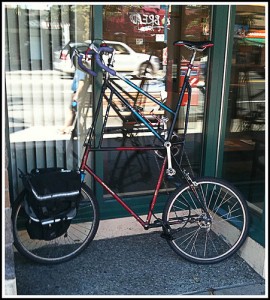 Making sure your bike fits you is one of the first steps you should take after getting a new bike. If you have been riding your bike for a while and haven’t done this yet, we recommend doing it immediately. When riding your bike for extended distances, an ill fitting bike can cause pain or damage. While we understand biking is not supposed to be easy, causing unnecessary damage to your joints and back is just stupid. While the advice given here is specific for road or urban bikes, many principles apply to any upright bicycle.
Making sure your bike fits you is one of the first steps you should take after getting a new bike. If you have been riding your bike for a while and haven’t done this yet, we recommend doing it immediately. When riding your bike for extended distances, an ill fitting bike can cause pain or damage. While we understand biking is not supposed to be easy, causing unnecessary damage to your joints and back is just stupid. While the advice given here is specific for road or urban bikes, many principles apply to any upright bicycle.
Standover Height
- When selecting a bike, throw one leg over the top tube and straddle the bike. You should have about one inch of clearance between your body and the tube of the bike if the bike has a traditional straight top tube, that is parallel to the ground. If it is sloped, you should have about two inches, depending on the pronouncement of the slope.
- Make sure to wear whatever shoes you will be cycling in when measuring. The thickness of your soles will contribute to your final leg length.
Saddle Height
- When you hit the bottom of your leg stroke, your knee should be 80-90% extended. If you have experienced consistent knee pain, this is probably the culprit. If it is in the front of your knee, you are probably under extending on your down stroke. Over extending can cause pain in the back of your knee, and it also causes you to lose significant power.
- Adjust and secure your saddle height accordingly.
Seat Position
- Your seat can also be moved forward and back to ensure proper form.
- When seated, you should be able to drop a straight line from the bottom of your knee cap to just behind your toes. This will increase comfort and power. Most riders will end up riding with their shins angled slightly forward.
- Keep your saddle parallel to the ground.
Choosing the right stem
- Stems connect your handle bars to your bike and come in a variety of lengths and angles. If you have to fully extend and lock your arms to reach your handle bars, you should get a shorter stem. Arms should be bent slightly, helping you to absorb road shocks and preventing aches and fatigues.
- Your back should be at a 45° angle to the ground. This optimizes your head position and keeps all vital shifters and brakes in easy reach.
It should be noted that the intense aerodynamic positions used by racers help maximize speed, but are not comfortable for extended riding. If you want specifics on mountain bikes, please check out this great article here.
Photo courtesy of Randolph Croft.
